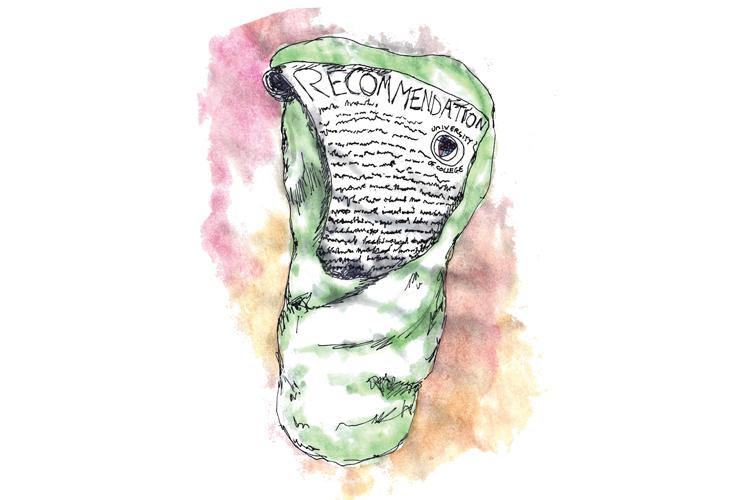A college application is littered with numbers—the GPA and scores of the ACT, SAT, SAT subject test scores and APs. Colleges use these figures to help them understand the academic profile of an applicant. But to get a deeper appreciation of a candidate, colleges look at a lot more than just those standardized numbers. They turn to college counselors and teachers to wax poetic pieces of work that will ultimately humanize a paper-bound applicant with a golden ticket: The Recommendation Letter.
Much like the development of a fetus in the womb of its mother, a letter of recommendation must be nurtured over many months before it is ready to be born and shown to the world. The first trimester of the letter’s development starts in April of junior year, when students are asked to formally ask two teachers to write them letters of recommendations.
Director of College Counseling Courtney Skerritt advises students on how to choose which teachers to ask for recommendations.
“Our general recommendation is one left brain, one right brain,” Skerritt said. “I’ll often tell girls, ‘You ask the teacher who you feel you gave the most raw material to,’ because that’s what’s going to make the most effective application.”
Senior Emma Deshpande followed Skerritt’s advice when asking teachers for letters.
“It’s easy to choose the teachers whose classes you have the best grades in, but I think that’s too simplistic,” Deshpande said. “A rec letter is the teacher vouching for a student; I wanted to choose teachers who I knew would vouch for me and tell my story well, portraying my failures as well as my successes.”
The second trimester in the development of the letter is the writing phase. Before school ends, the college counseling department holds an optional information session to discuss what a college letter of recommendation looks like.
“Our faculty come with such a strong background in academia that they are used to and are familiar with writing recommendation letters, [and] reading recommendation letters, so they already come to the table with expertise,” Skerritt said. “We hold a training every spring, so we’re telling them what we’re hearing from admissions officers and what we’re learning about at conferences.”
From then on, the letter is in the teacher’s hands.
History Department Chair Steve Kramer writes several letters of recommendations each year. In order to prepare to write a letter, he asks his students to provide all the writing they completed that year, a copy of the front and back of the title page of their JRP, the self-assessment provided by the college counseling department and a resume if the student has one.
“I always like to have something unique to open up the rec,” Kramer said. “What the goal is, I want that incident, example, story to grab their attention.”
Kramer handwrites each letter of recommendation before typing up his masterpiece, finishing the five hour process.
“Once I handwrite it I like it to percolate for a while and come back to it. When the Romans were building their agoras, they often built their foundations and let it sit for a couple years before they came back to it,” Kramer said. “I like the idea of letting it sit for a while.”
Upper School Spanish Teacher Alejandra Suarez uses a “straightforward approach” when she writes letters of recommendations for her students.
“I always keep notes on things that students do so that I can remember specific things if they ask me to write [a letter of recommendation] for them,” Suarez said. “I have a list of adjectives that I have next to my computer and I post that and I keep adding adjectives.”
Like Suarez, Dean of Studies and Upper School science teacher Barbara Fishel keeps a list of powerful words next to her when writing her letters of recommendations. After receiving the classroom assessment that college counseling asks all students to fill out to evaluate their own experience in the clas, Fishel compares this to her own observations about the students.
“I also use the comments that I’ve written. I use other pieces of information like if they’ve been in some extracurricular that I’ve seen and I feel that has bearing on something that I want to say. I start by pulling anything I have [about the student] on a piece of paper,” Fishel said. “I try to weave a story about the student that puts the student in the best light as possible.”
After the teachers and counselors finish their letters of recommendations, they are ready to be born to the world and ready to be read by colleges.
As the Senior Assistant Director of Undergraduate Admissions at Northwestern University, Andrew Linnehan uses letters of recommendations from teachers and counselors to get to know the student in a way that standardized test scores can’t explain.
“In a school as selective as we are, we really need to put more emphasis on some more ‘getting to know the student,’” Linnehan said. “We aren’t reading each recommendation to necessarily see how talented a student is or how ‘great’ they are; we are really reading them to get to know you more through the eyes of someone who knows you a lot better than we do.”
But according to Linnehan, for a college to get a better understanding of an applicant’s background, the admissions officers give the same amount of consideration to the applicant’s personal essays as they do to the letters of recommendation.
“The teacher and the counselor rec is just as important as the student’s essays because they are two different perspectives that get you into the next level with the student,” Linnehan said. “We want both of those perspectives to get the complete picture.”
– Ashna Kumar – Web Editor –


